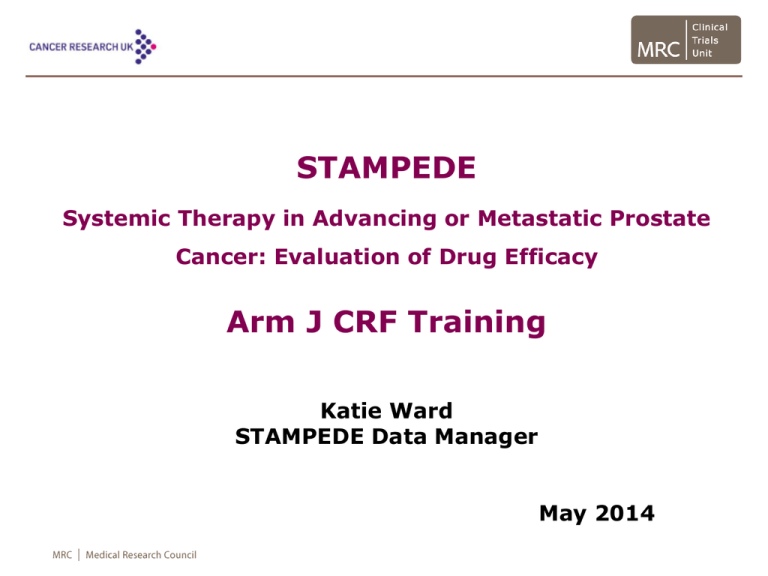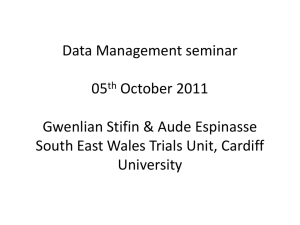Follow-up Form – Page 1
advertisement

STAMPEDE Systemic Therapy in Advancing or Metastatic Prostate Cancer: Evaluation of Drug Efficacy Arm J CRF Training Katie Ward STAMPEDE Data Manager May 2014 Overview • Arm J CRF changes - indicated in purple • General CRF training - indicated in black • Reporting progression • Reporting SAEs Randomisation Form – Page 1 Inclusion and Exclusion Criteria New exclusion criteria added Ensure that the patient’s eligibility is checked before randomisation, and that all boxes are unambiguously ticked to confirm this. Randomisation Form – Page 2 The PSA value provided should be the most recent test result prior to the start of hormone therapy. Q15 should be answered as 0=None if the patient is not relapsing (broad disease category 4). Randomisation Form – Page 3 Any contraindications to radiotherapy should be discussed with the trial team prior to randomisation. Intended start date of trial treatment should be within 4 weeks of randomisation. Q27c is not asked on the randomisation server but should still be completed for all metastatic patients and all patients planned to receive RT to the prostate as part of standard treatment. Baseline Form – Page 1 Please remember to indicate whether an AST or ALT measurement is provided here by crossing through as appropriate. If endocrinology prior to hormone therapy is not available, please answer 0=No to Q23 and go to Q26. If endocrinology is available prior to HT, please answer 1=Yes to Q23 and answer Q24 and 25. All blood tests should be taken within 8 weeks prior to randomisation. These questions relate to initial disease presentation, not the current disease status. Relapsing patients: provide earliest date of diagnosis. Baseline Form – Page 2 Please remember to provide the type and dose if Q32 is answered 1 or 4, and if Q35 is answered is answered 1=Yes. Please provide as much information as possible relating to concomitant medications. If full dates are not known, try to provide partial dates. If any information is definitely not available, please write ‘Not Known’ or ‘NK’ accordingly. Cardiovascular Form This refers to the patient’s current smoking status, not whether they have previously smoked. If any of these questions (Q14-Q18) are answered 2=Yes and patient is ineligible, the patient should not be randomised. Bone Density Risk Factor Questionnaire This CRF should be completed for all patients prior to randomisation, and does not relate to the bone mineral density sub-study. Arm J: Safety analysis • First safety review – first 50 patients allocated to Arm A and first 50 patients allocated to Arm J on trial for ~6wks • Second safety review – first 50 patients allocated to Arm A and first 50 patients allocated to Arm J on trial for ~6mths • Additional safety reviews at the request of the IDMC • Please submit all follow-up forms in a timely manner. Any outstanding CRFs will be chased regularly in view of the safety analyses. Follow-up schedule 6 weekly 12 weekly 6 monthly Annually Randomisation to 24 weeks 24 weeks to 2 years 2 years to 5 years Thereafter • Follow-up dates will be sent to you on a treatment and follow-up schedule each time you randomise a patient. • The expected follow-up dates on the treatment schedule are calculated from the date of randomisation. • If a patient fails to attend a follow-up visit, please submit a follow-up form marked with the appropriate week number and a note to say ‘missed visit’. Follow-up Form – Page 1 The week number should always correspond to the follow-up schedule (i.e. week 6, 12, 18). If Q9 or Q12 are answered 1=Yes, an Abiraterone and Enzalutamide Treatment Form should be completed. Q9 and 12 should be answered 1=Yes for all Arm G and Arm J patients at week 6 and the start of abiraterone and/or enzalutamide treatment should be reported on the Abiraterone and Enzalutamide Treatment Form. If Q5, 6 or 7 are answered 1=Yes, a progression form should also be completed. If Q8 is answered 1=Yes, a Hormone Therapy Treatment Form should be completed. Compliance: report number of tablets missed rather than days. The addition of Q11 now requires the daily dose of prednisolone to be reported for all Arm G and J patients. Hormone Therapy Form This CRF only needs to be completed when there has been a change to hormone therapy since the last reported assessment. At week 6, Q3 does not need to be answered ‘started’ if treatment with LHRH was reported at randomisation and has not changed. Please remember to answer Q8 and Q13 as 0=No if treatment has not changed. Abiraterone and Enzalutamide Treatment Form This CRF should be completed alongside the follow-up form for all patients on Arms G and J at week 6. The week number and date of assessment should correspond to the relevant follow-up form. Thereafter, it should only be completed alongside the follow-up form when there is a change in abiraterone or enzaluatmide treatment. For Arm J patients, if treatment to only one of the trial drugs has changed, please answer ‘0=No, treatment continues as before’ for the other trial drug. Follow-up Form – Page 2 Waist measurements should be reported on the baseline form and at annual follow-ups. 0 1 0 Equally, if the Yes/No question for a group has been answered as 0=No, grades should not be entered for any of the listed toxicities. In this instance, any grade above 0 will result in a data query. 0 0 0 0 0 0 0 0 3 2 Nocturia If the Yes/No question for a group has been answered as 1=Yes, please ensure a grade is reported for all toxicities listed. If the toxicity is not present, please enter ‘0’. Boxes left blank will result in a data query. Please also remember to describe any ‘other’ toxicities. Follow-up Form – Page 3 New toxicities added Follow-up Form – Page 4 RTOG late side effects to be completed for all patients having radiotherapy – “2=not applicable” added as option. Follow-up Form (Post-Progression) This CRF should be completed at each follow-up visit following progression. Arm G and Arm J patients: this CRF should only be completed when all types of progression have been reported or a second-line treatment has been prescribed. Until this time, the regular follow-up form (including toxicities) should be used. PSA test results should be reported for all patients post-progression Progression and Additional Treatment Form – Page 1 ‘2=First instance already reported’ is now an option for biochemical failure and all other types of progression (please see key in table). This CRF should be completed when a patient’s disease progression is confirmed. Each type of progression only needs to be reported once, the first time it occurs. Questions remain the same; layout has changed to hopefully capture data more easily. Questions have been added to gain further data on skeletal-related events. For example, has the SRE been confirmed as disease progression? Reporting Biochemical Failure • Confirmatory PSA test between 1 week and 3 months later: • If value is ≥PSA progression value then report biochemical progression • If the clinician adds anti-androgens to control a rising PSA: • Report progression • PSA progression emails are sent to sites approx. 3-monthly • Baseline and FU forms up to week 24 needed • Alternatively contact the trial team for help Progression and Additional Treatment Form – Page 2 Please ensure an answer is given to all listed treatments. If a treatment was not given, enter a ‘0’ Any blank fields will result in a data query. If the finish date is not known because the treatment is ongoing, please ensure that the question ‘ongoing’ is answered as 1=Yes. LHRH removed New treatments for progression added. These include: enzalutamide (not trial treatment), prednisolone, dexamethasone, radium-223. Please note that †1 relates to question 24, †2 to 25 and †3 to 26. Additional Treatment Update Form This CRF should be used to report new information about a patient’s treatment for progression – the type of progression itself must already have been reported on a Progression and Additional Treatment Form. SAE Form The main event should be noted along with the date of onset (e.g. when the patient was admitted to hospital) and the current status. CRFs can up updated with resolution details. Causality and expectedness should both be completed to assess if an event is a SAE, SAR or SUSAR. If a new event occurs whilst in hospital and it is not an associated symptom, it should be reported on a new CRF. All trial medication details (including information for HT, whether just on Arm A or not) should be provided. Clinician should sign and date both pages of the SAE form Notifications and Responsibilities • Investigators must notify the MRC CTU of all SAEs occurring from the time of randomisation up until 30 days after the last protocol treatment administration • SAEs occurring in patients randomised to Arm A must be reported until 30 days after last injection or progression (whichever is sooner) • SARs and SUSARs must be notified to the MRC CTU (i.e. no matter when they occur after randomisation) • SAEs must be notified using the appropriate SAE form by fax +44 (0) 2076704818 Exceptions • Disease progression • Death as result of disease progression • Elective hospitalisation and surgery for treatment of locally advanced or metastatic cancer or its complications • Elective hospitalisation for pre-existing conditions that have not been exacerbated by trial treatment • Elective hospitalisation for pre-existing conditions to simplify treatment or procedures Radiotherapy Detail Form This CRF is expected for all patients, irrespective of arm allocation. If radiotherapy wasn’t planned and wasn’t given, answer Q1 as 0=No and the form is complete. If radiotherapy wasn’t given but was planned at randomisation or the patient is on Arm H, please complete Q1a, specifying why radiotherapy was not given. For patients who receive RT, this CRF should be completed when the patient’s primary course of RT is completed. For patients who do not receive primary RT, it should be completed 10 months after randomisation to confirm RT was not given. Please check the answer to Q8 carefully. Usually on STAMPEDE CRFs 0=No and 1=Yes, but here the answers are reversed. Radiotherapy Acute Toxicity Form This CRF should be completed for all patients who receive primary RT. Arm H patients: it should be completed 10 weeks after the start of RT. All other patients: it should be completed 18 weeks after the start of RT. Toxicities can be completed on alternate weeks, as long as all missing weeks are completed retrospectively. Toxicities can also be recorded via telephone follow-up with the patient. End of Treatment Form This CRF should be completed whenever a patient permanently stops trial treatment, other than radiotherapy. If a patient never started trial treatment, please submit an end of treatment form detailing this on the CRF. Please record the status of each treatment and check that the information about treatment end has been entered into the correct column. Enzalutamide column added. Death Form This CRF should be completed as soon as possible after a patient has died. If there were no other contributing causes of death, enter ‘00’ for questions 3, 4 or 5. Please ensure an anonymised copy of the post-mortem is submitted to the CTU. Co-enrolment Form This CRF should be completed when a patient enrols in another clinical trial after randomisation. Quality of Life Form • If the patient has consented to participate in the Quality of Life study, a copy of the form should be completed at baseline and alongside every follow-up visit. • Quality of Life forms should be completed for Arm G and Arm J patients until all types of progression have been reported. • Quality of Life forms do not need to be completed postprogression for patients on all other arms. • Please email the trial team for a copy of the Quality of Life Form. End of Trial Participation Form This CRF should not be used if the patient is stopping treatment early. In this instance, please use an End of Treatment Form. Following discussion with the patient and trial team, this CRF should only be used if the patient wishes to end their trial participation. General CRF Completion Tips • Please ensure the most up-to-date version of the CRF is being used. • CRFs should always be signed and dated on the date of completion by a member of staff listed on the STAMPEDE delegation log. • If a mistake if made, please cross through the original answer with a single line, and initial and date the correction. • Please report values in the units provided on the CRFs. • If an answer is not known, please write ‘not known’ or ‘NK’ next to the question. If a test was not carried out, please write ‘not done’ or ‘ND’ next to the question. Contact us Web: www.stampedetrial.org MRC Francesca Schiavone Clinical Trial Manager T: +44 (0) 207 670 4632 E: mrcctu.stampede@ucl.ac.uk Alanna Brown Clinical Trial Manager T: +44 (0) 207 670 4882 E: mrcctu.stampede@ucl.ac.uk Dominic Hague, Katie Ward, Peter Vaughan STAMPEDE Data Managers T: +44 (0) 207 670 4809 / 4794 / 4947 E: mrcctu.stampede@ucl.ac.uk





